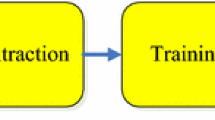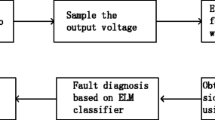Abstract
This paper proposes a method of analog circuit fault diagnosis by using high-order cumulants and information fusion. We extract the original voltage and current signals from output terminal of the circuit under test, and determine corresponding kurtosis and skewness as fault eigenvectors, which are then used to improve Error Back Propagation (BP) neural network for fault diagnosis. With respect to fault eigenvectors consider more about the information which are sometimes ignored by principal component analysis (PCA) using second order statistics. By employing information fusion to integrate voltage with current as fault eigenvectors, eigenvectors can be used to express fault information better. Diagnosis examples are used to illustrate that our fault eigenvectors own higher recognition rate and diagnosis accuracy.









Similar content being viewed by others
References
Aminiam F, Aminian M (2002) Analog fault diagnosis of actual circuits using neural networks. IEEE Trans Instrument Measure 51(30):151–156
Bishop CM (1995) Neural networks for pattern recognition. Oxford University Press, Oxford, pp 15–63
Bo F, Peng X, Junjie L (2009) Analog circuit fault diagnosis based on neural network and fuzzy logic. Proc Control Decision Conf 17–19:199–202
Cheng W, Bin SX, Le XY (2007) Fault diagnosis in analog circuits based on neural network information fusion technique. J Circ Syst 12(5):25–29
Deliyannis T, Sun Y, Fidler JK (1999) Continuous-time active filter design. CRC Press, Boca Raton, p 26
Devarakond SK, Sen S, Bhattacharya S, Chatterjee A (2012) Concurrent device/specification cause-effect monitoring for yield diagnosis using alternate diagnostic signatures. IEEE Design Test Comput 29(1):48–58
Grzechca D, Golonek T, Rutkowski J (2007) The use of simulated annealing with fuzzy objective function to optimal frequency selection for analog circuit diagnosis. Proc IEEE Int Conf Electr Circ Syst 11–14:899–902
Guoming S, Shuyan J, Houjun W (2011) Analog circuit fault diagnosis approach using optimized SVMs based on MST algorithm. Proc10th Int Conf Electr Measure Inst 16–19:236–240
Huang K, Stratigopoulos H-G, Mir S, Hora C, Xing Y, Kruseman B (2012) Diagnosis of local spot defects in analog circuits. IEEE Trans Instrum Meas 61(10):2701–2712
Huang K, Stratigopoulos H-G, Mir S (2010) Fault diagnosis of analog circuits based on machine learning. Proc of Design Auto Test Eur Conf (DATE) 8–12:1761–1766
Jin-Long AN, Zhen-Ping MA (2010) Study on the method of fault diagnosis in analog circuits based on new multi-class SVM. Proc Int Conf Mach Learn Cybernet 11–14:1500–1504
Li H, Yin B, Li N (2010) Research of fault diagnosis method of analog circuit based on improved support vector machines. Proc 2nd Int Conf Indust Mechatro Automat 30–31:494–497
MartinT. Hagan,Howard B.Demuth,Mark H.Beale (2002) Neural network design, China Machine Press,pp.227-255
Nawi NM, Ransing RS, Ransing MR (2008) A new method to improve the gradient based search direction to enhance the computational efficiency of back propagation based neural network algorithms. Proc Sec Asia Int Conf Model Simul 13–15:549–551
Qin X, Han B, Cui L (2011) A kind integrated adaptive fuzzy neural network tolerance analog circuit fault diagnosis method. Proc IEEE Int Conf Comput Control Industr Eng 20–21:180–183
Shivappa ST, Trivedi MM, Rao BD (2010) Audiovisual information fusion in human–computer interfaces and intelligent environments: a survey. Proc IEEE 98(10):1692–1715
Sun S (2007) Optimal and self-tuning information fusion Kalman multi-step predictor. Aerospace Electro Syst 43(2):418–427
Tang J, Shi Y, Zhang W (2008) Analog circuit fault diagnosis based on support vector machine ensemble. Chinese J Sci Instru 29(6):1216–1220
Viera S, Pavol M, Marek M (2005) Defect detection in analog and mixed circuits by neural networks using wavelet analysis. IEEE Trans Reliab 54(3):441–448
Yu J, Hong L (2007) Fault diagnosis of analog circuit based on wavelet neural network. Chinese J Sci Instru 28(9):1600–1603
Zhang Y, Ji Q (2010) Efficient sensor selection for active information fusion, systems, man, and cybernetics. Part B Cybernet 40(3):719–728
Zhu W, He Y (2009) Neural network based soft fault diagnosis of analog circuit with tolerances[J]. Trans China Electrotech Soc 24(11):184–191
This work was supported by the National Natural Science Funds of China for Distinguished Young Scholar under Grant No. 50925727, National Natural Science Foundation of China under Grant No.60876022, High-Tech Research and Development Program of China under Grant No. 2006AA04A104, Hunan Provincial Science and Technology Foundation of China under Grant No.2008GK2022, the cooperation project in industry, education and research of Guangdong province and Ministry of Education of China under Grant No.2009B090300196.
Dr Fund of Hunan University of Science and Technology under Grant No.E51366.
Author information
Authors and Affiliations
Corresponding author
Additional information
Responsible Editor: H. Stratigopoulos
Rights and permissions
About this article
Cite this article
Xie, T., He, Y. Fault Diagnosis of Analog Circuit Based on High-Order Cumulants and Information Fusion. J Electron Test 30, 505–514 (2014). https://doi.org/10.1007/s10836-014-5478-0
Received:
Accepted:
Published:
Issue Date:
DOI: https://doi.org/10.1007/s10836-014-5478-0




